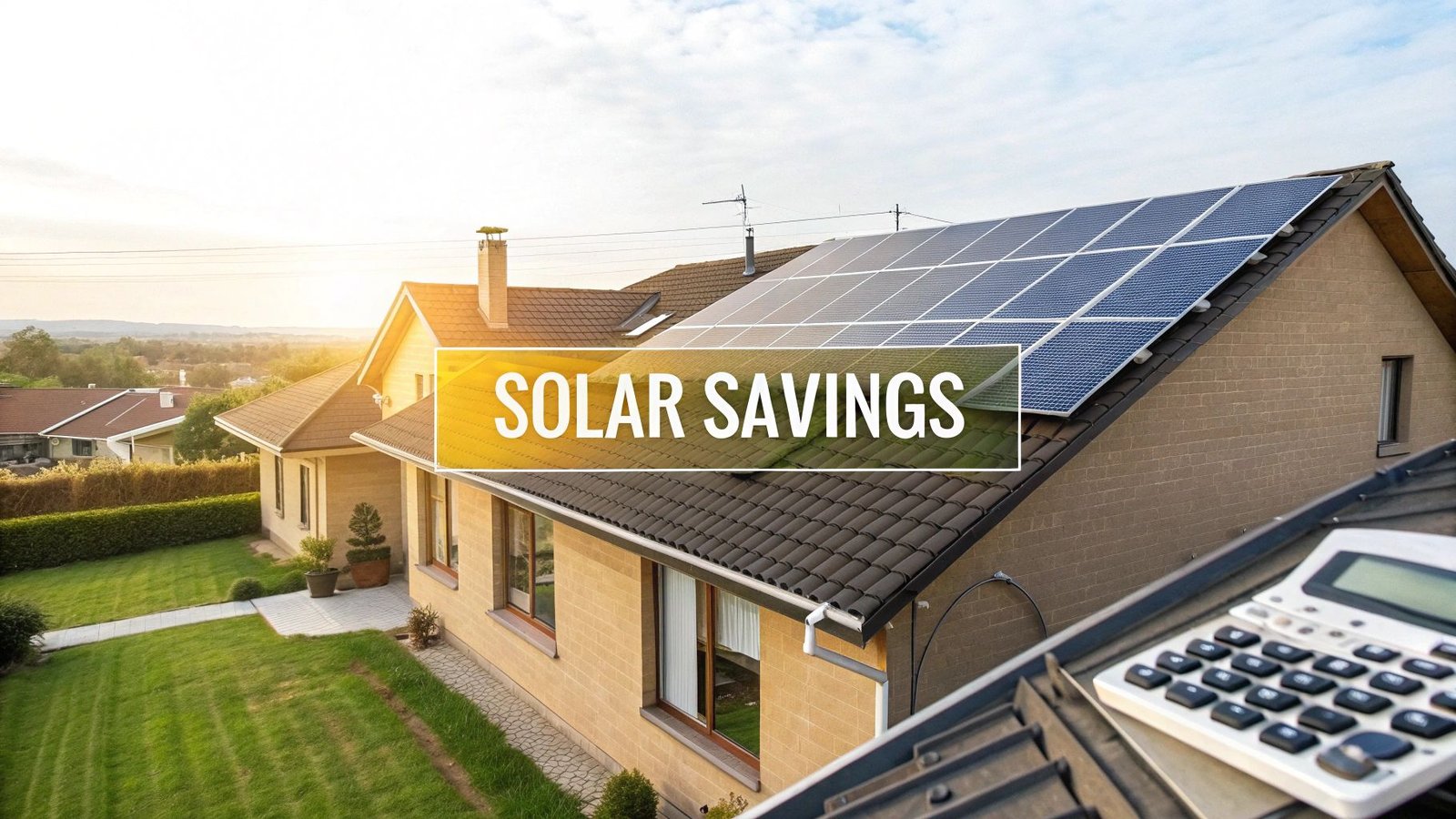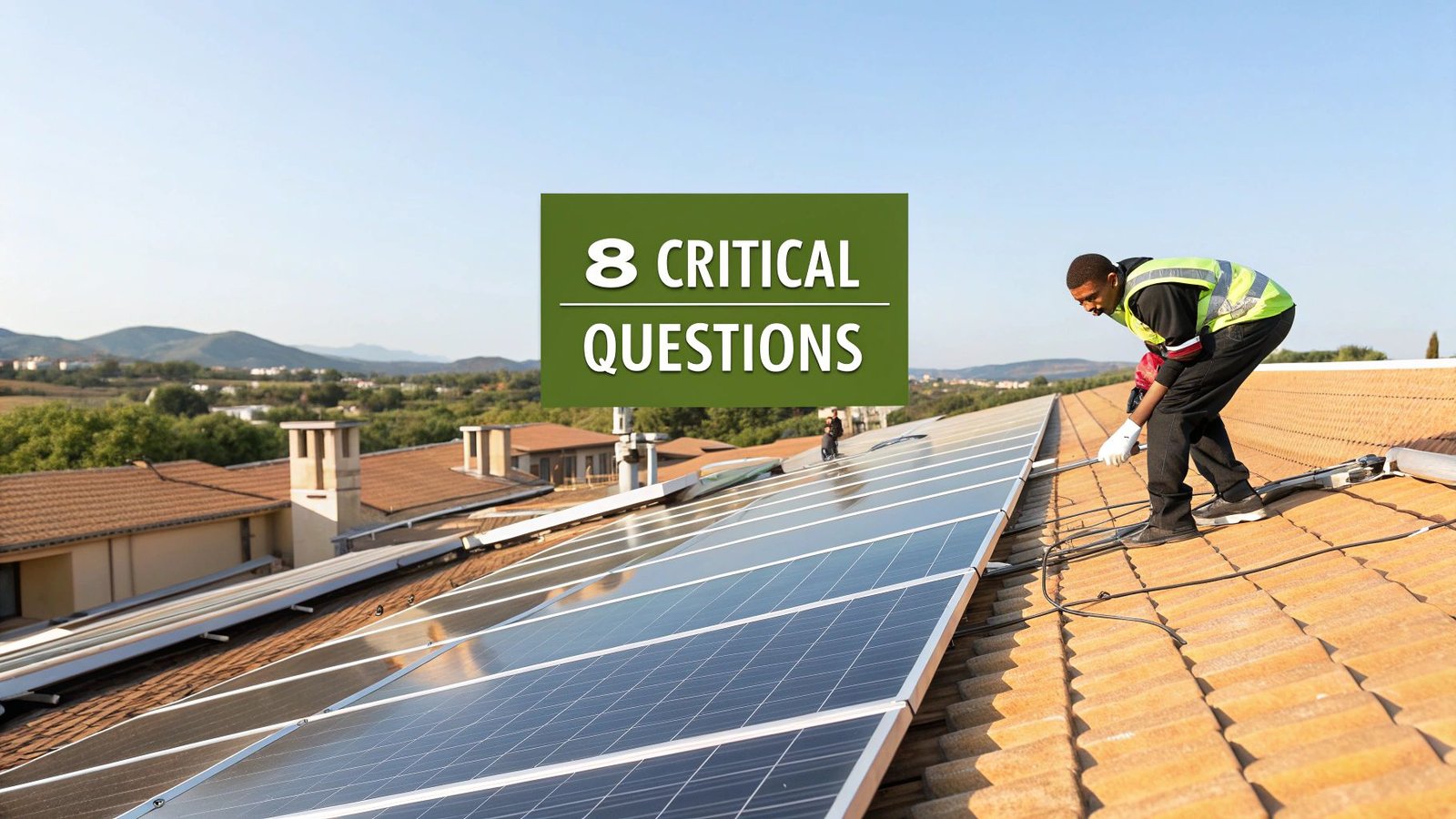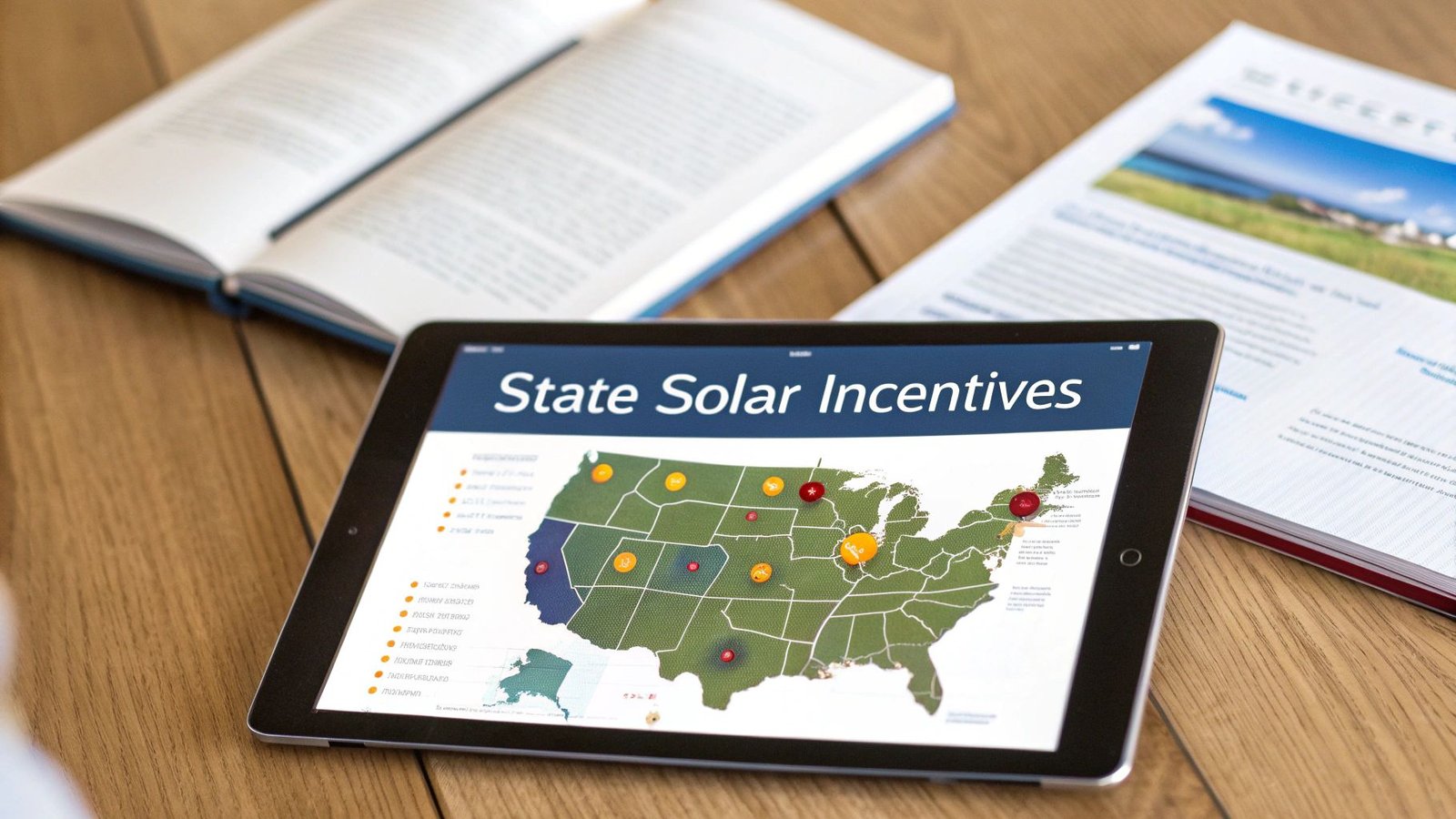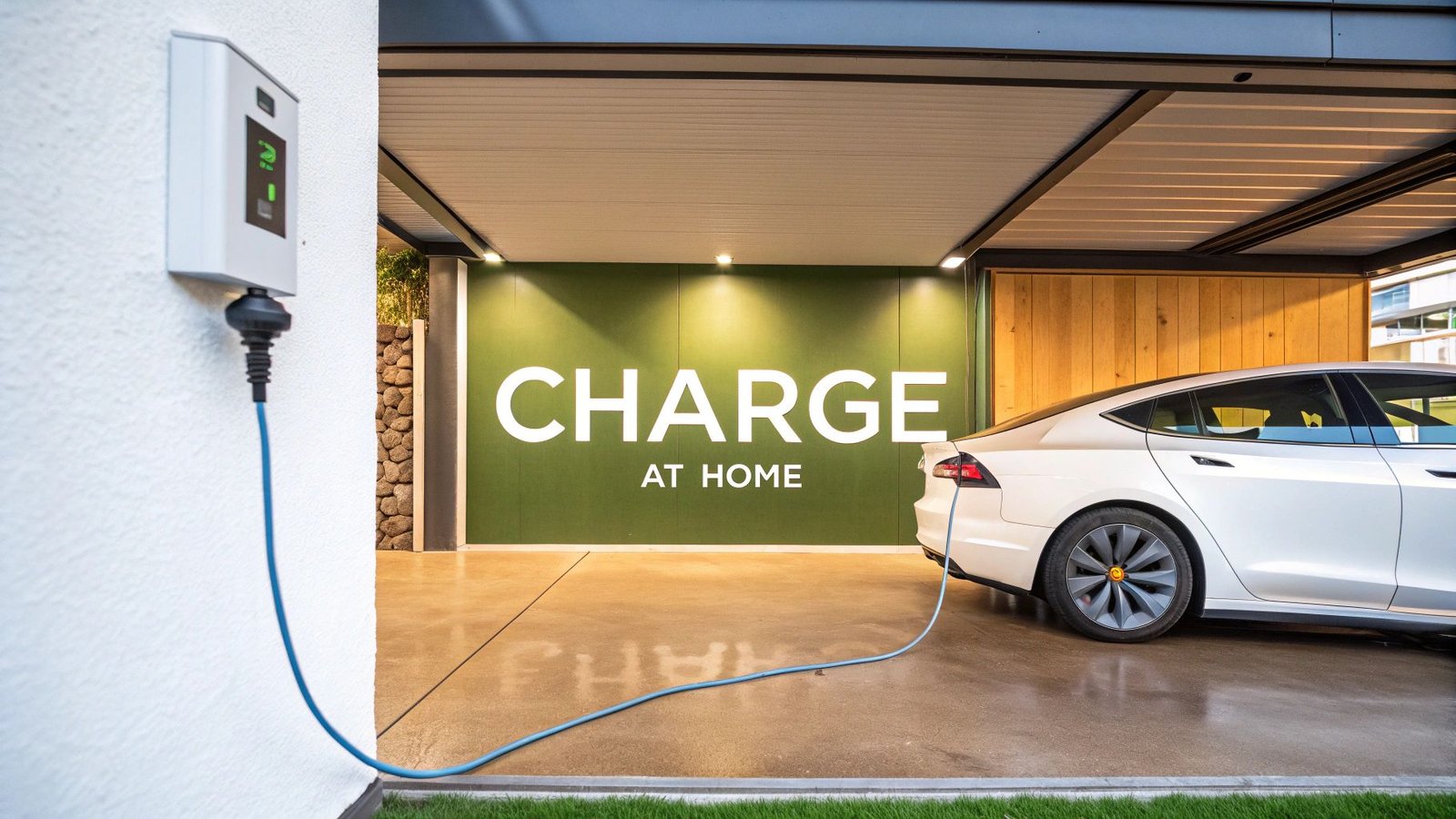A solar energy calculator for home is the perfect tool to move past guesswork and get a real, data-driven estimate of your potential savings. It analyzes your roof, your current energy use, and local utility rates to give you a clear, powerful starting point for your solar journey.
Your Starting Point For Solar Savings
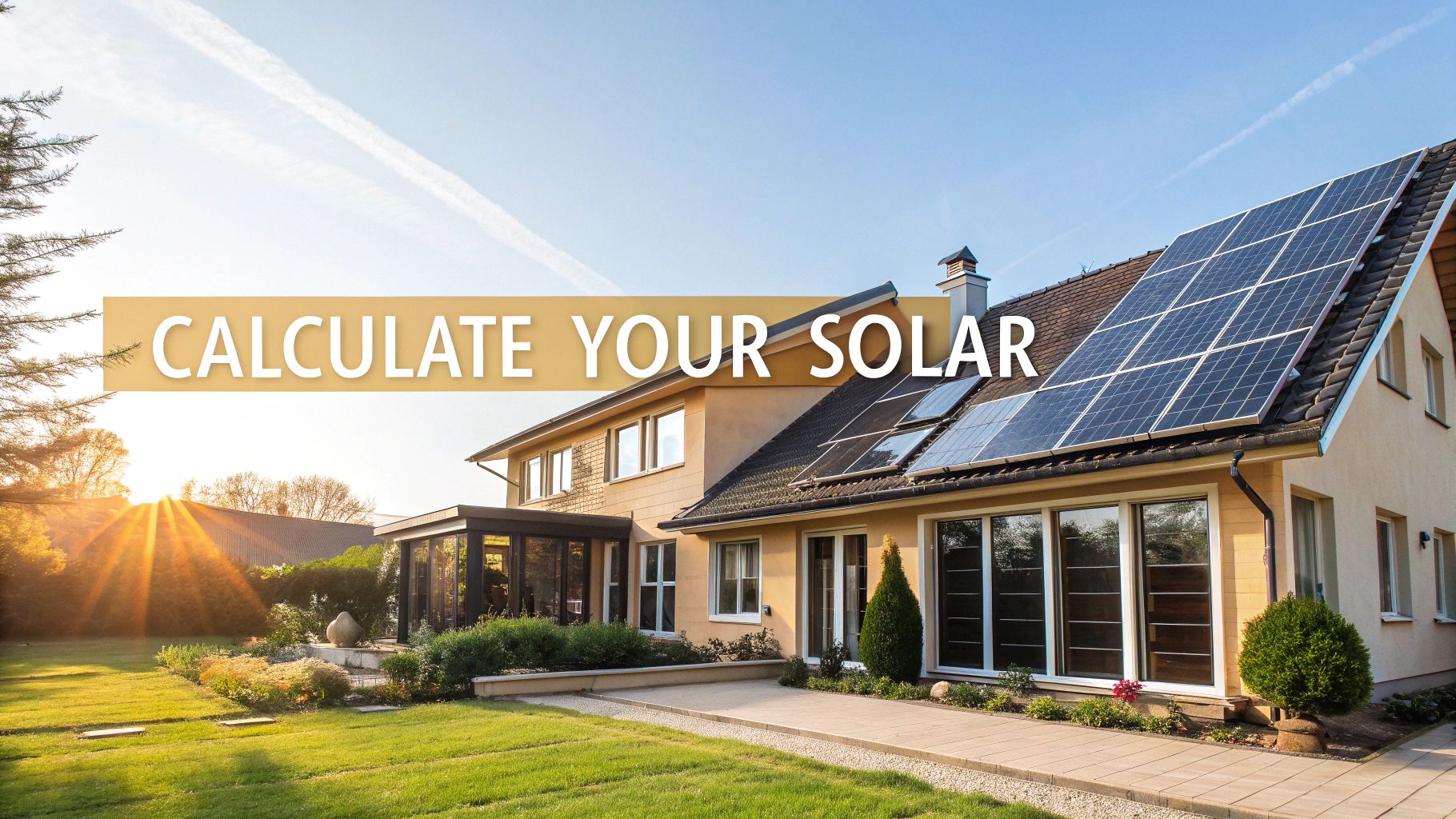
Before you even think about investing thousands in solar panels, the most important thing you can do is understand your own home's unique potential. That’s exactly what a solar energy calculator is built for. It takes what feels like a complicated decision and boils it down into a financial snapshot you can actually work with.
Instead of throwing generic numbers around, these tools give you a personalized estimate based on factors that matter to you. Think of it as a financial forecast for your roof.
How The Calculation Works
Behind the scenes, the calculator's algorithm is crunching several key data points to create your estimate. The most crucial inputs are your home's address, your average monthly electric bill, and who your utility provider is. Many of the best tools today even use satellite imagery to get a good look at your roof's layout and potential.
This process gives the calculator everything it needs to estimate:
- Sunlight Exposure: It figures out how many hours of direct sunlight hit your roof each day, factoring in things like roof direction and shade from nearby trees.
- System Size: Based on how much electricity you use, it will recommend the right-sized system for your needs, like a 5kW o 8kW system.
- Projected Savings: It then multiplies the estimated energy production by your local electricity rate to show you what you could save.
A good calculator does more than just show you a price tag; it reveals your payback period—the time it will take for your energy savings to completely cover the initial investment. This is one of the most important numbers for judging the long-term value of going solar.
Beyond The Solar Panels
Ultimately, running the numbers through a solar calculator empowers you to make a confident, well-informed choice. It gives you a solid baseline to compare quotes from professional installers and helps you grasp the variables that will affect your return on investment.
Remember, the panels are just one part of the equation. Your home's overall energy efficiency plays a huge role in maximizing savings. For example, it might be worth exploring the energy-saving benefits of metal roofing, since a more reflective and better-insulated roof can significantly lower your home's total energy demand in the first place.
Get a Handle on Your Home's Energy Data
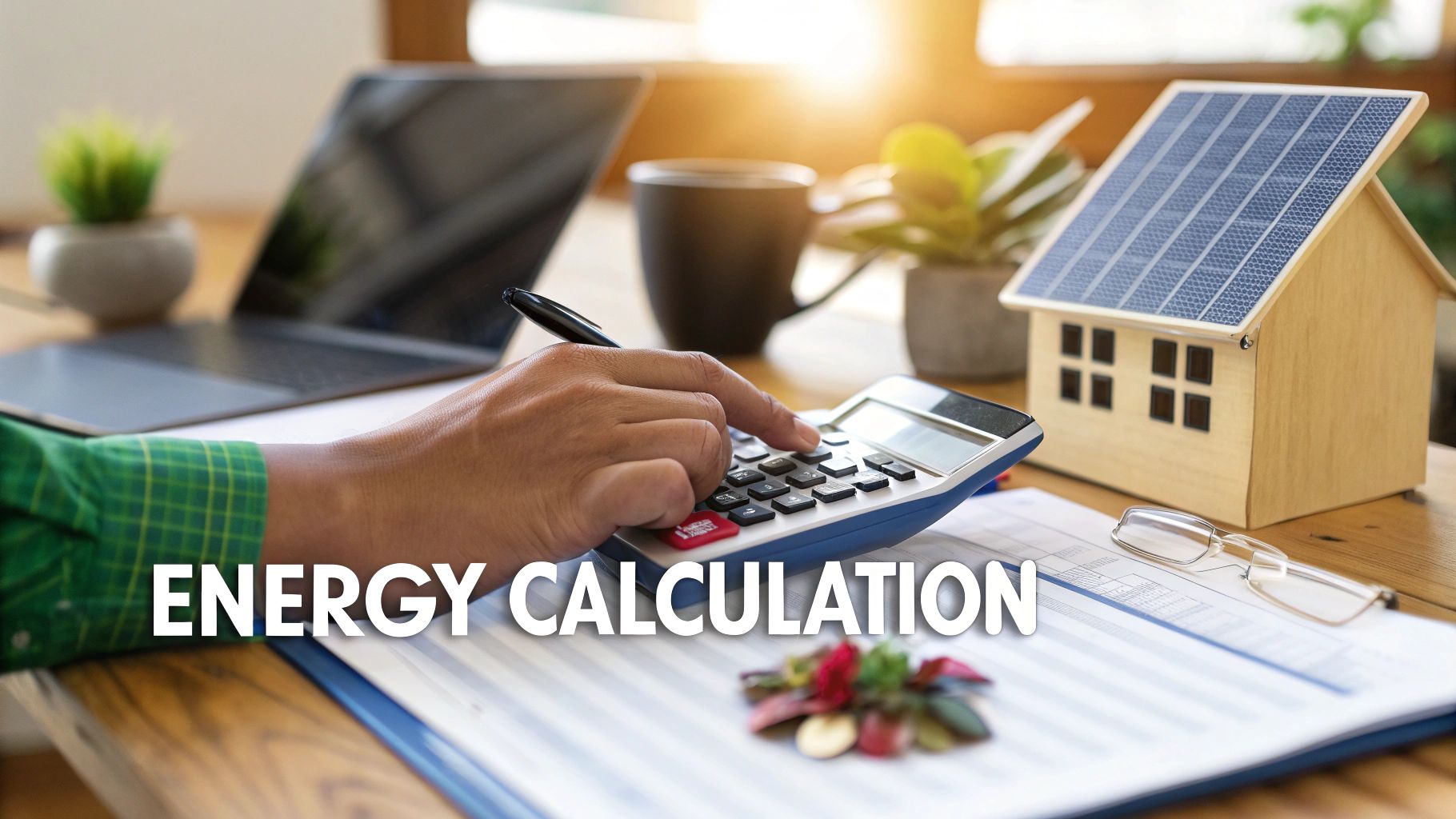
Any good solar estimate is built on a foundation of solid data. Before you even think about plugging numbers into a solar energy calculator for home, you've got to do a little homework. Think of it like gathering ingredients before you start cooking—the quality of what you put in directly impacts the final result.
The most critical piece of the puzzle is your monthly electricity consumption, which you'll find on your utility bill measured in kilowatt-hours (kWh). To get the most out of any solar calculator, it’s worth taking a moment to understand how to calculate your electrical energy consumption. This number is everything; it tells the calculator exactly how much power your future solar system needs to produce to cover your needs.
Is Your Home Ready for Solar Panels?
Once you have your energy usage, it's time to look up—at your roof. The physical layout and condition of your roof are huge factors in how much power your panels can actually generate.
You'll need to note a few things:
- Roof Direction: Is your roof facing south? In the Northern Hemisphere, that’s the sweet spot for maximum sun exposure. But don't worry, east and west-facing roofs are still great contenders.
- Roof Pitch: The angle of your roof matters. Most calculators can handle any pitch, but a slope between 30 and 45 degrees is generally considered optimal for capturing sunlight.
- Shade Issues: Walk around your property at different times of the day. Are there any tall trees, nearby buildings, or even a chimney that might cast a shadow on your roof? Shading can significantly impact energy production.
This isn't just busywork. Getting these details right is your first step in joining a massive global movement. Projections show that by 2050, solar could make up 50% of all electricity generation. For homeowners, a well-planned system can slash energy bills by 20-50%.
Projected Growth of Solar in Global Electricity Generation
Year | Solar's Share
-----|--------------
2025 | ~10%
2035 | ~25%
2050 | ~50%
Finally, grab one more number from your utility bill: your average cost per kWh. This is the rate your utility company charges you for electricity, and it's the key to calculating your potential savings.
Your electricity rate is the multiplier for your savings. The higher your current rate, the more money solar panels will save you each month, leading to a faster return on your investment.
To make this easier, here's a quick checklist of the information you'll want to have on hand.
Your Solar Calculation Data Checklist
Collect this key information before using a solar calculator to ensure your estimate is as accurate as possible.
| Data Point | Where to Find It | Por qué es importante |
|---|---|---|
| Average Monthly kWh | Your electricity bill (look for a 12-month summary) | This is the baseline for sizing your system. |
| Electricity Rate ($/kWh) | Your electricity bill | Determines your potential financial savings. |
| Roof Direction | A compass app on your phone or Google Maps | A south-facing roof gets the most sun. |
| Roof Pitch (Angle) | A visual estimate or a protractor app | Affects how directly sunlight hits the panels. |
| Potential Shading | A visual inspection of your property | Shadows reduce the energy your panels can generate. |
With these details collected, you're ready to get a far more realistic and useful estimate from any solar calculator.
How To Use A Solar Savings Calculator
Now that you have your home's energy data, you're ready to plug it into a solar calculator. Think of these online tools as your personal financial forecaster for solar, turning a few key pieces of information into a surprisingly detailed estimate.
It All Starts With Your Address
The first thing most calculators ask for is your street address. This isn't just to find you on a map; modern tools use satellite imagery to get a bird's-eye view of your property. They instantly analyze your roof's size, its direction (is it facing south for maximum sun?), and even identify potential shade from nearby trees or buildings.
You can see below how a tool like Google's Project Sunroof kicks things off just by knowing where you live.
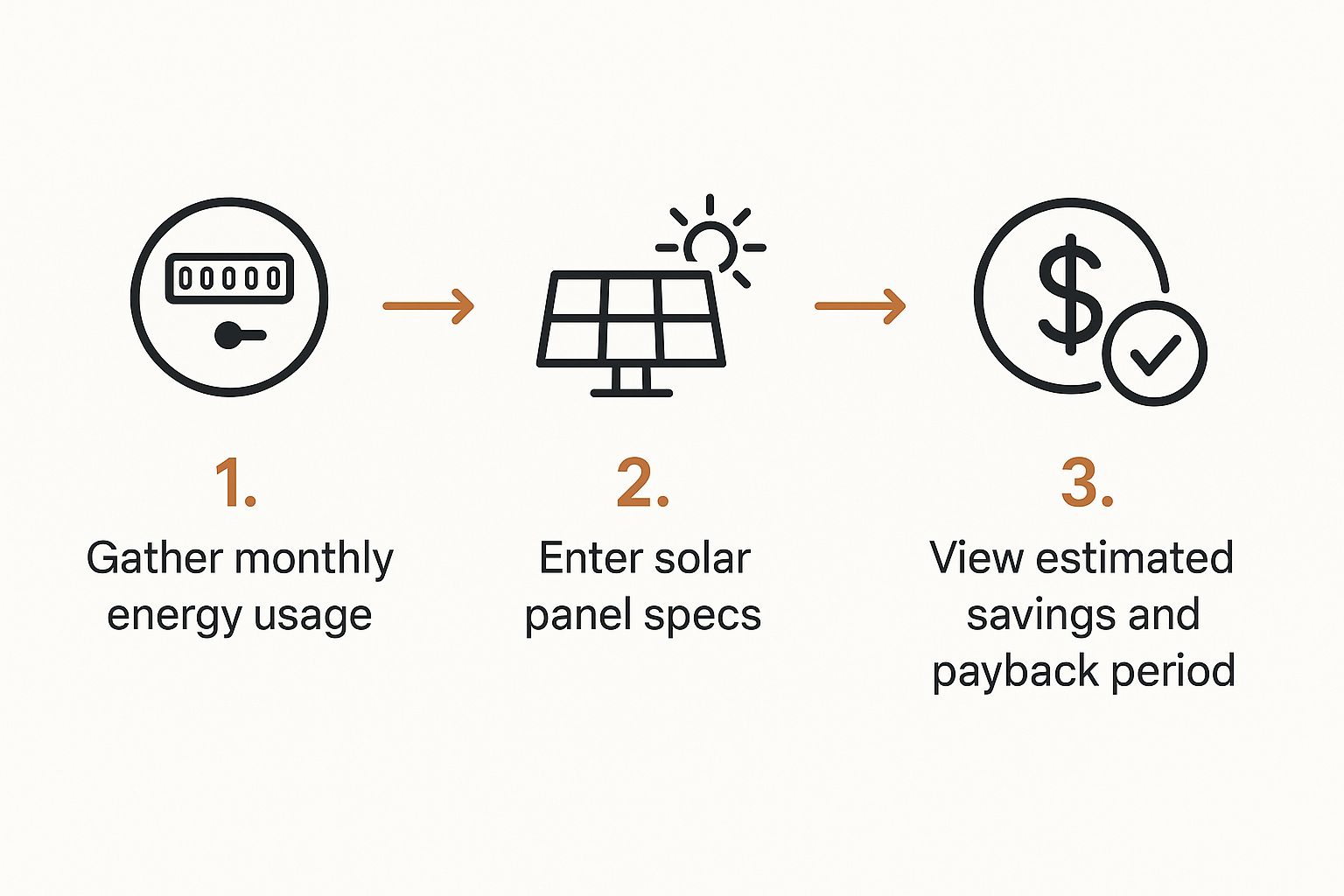
This initial step is powerful because it gives the calculator the physical and geographic context it needs to start crunching the numbers on your home's solar potential.
Plugging In the Financials
Next, you'll be asked for your average monthly electricity bill or, even better, your specific kWh usage from the data you just gathered. This is where your homework really pays off. A precise 12-month average will give you a far more reliable estimate than just guessing.
You'll also need to identify your utility company. This is a critical piece of the puzzle. The calculator uses this to pull the correct local electricity rates, which directly impacts your projected savings. The higher your utility rate, the more valuable every single kilowatt-hour your solar panels produce becomes.
If you want to get even more granular with how your usage translates into the right number of panels, our solar system sizing calculator is a great resource to explore.
Consejo profesional: Remember, the core purpose of a solar calculator is to figure out how much of your current electricity bill can be wiped out by solar power. The more accurate your inputs, the more trustworthy the savings estimate will be.
Once you’ve put in all this information—your address, your usage, and your utility provider—you’re just one click away from seeing what solar could do for you.
Decoding Your Solar Estimate

Alright, you've plugged in your numbers, and now you’re looking at a report packed with charts, financial projections, and technical jargon. It can feel a bit overwhelming at first, but don't worry. This is where the magic happens—it’s your first real glimpse into how solar can change your monthly budget and give you energy independence.
The first thing that probably jumps out is the recommended system size. This is measured in kilowatts (kW). For a standard single-family home, you might see a number like 6.5 kW. This isn't just a random guess; the calculator crunched your electricity usage data to find the ideal size to offset most—or even all—of your utility bill without overspending on a system that's bigger than you need.
It's amazing to think that this kind of personalized calculation is now so accessible. It’s part of a massive global shift. The solar market was valued at a staggering $189.5 billion back in 2022 and is on track to hit $607.8 billion by 2030. That incredible growth, with global solar capacity jumping by 33% each year, means better technology and lower prices for homeowners like you. Curious about the bigger picture? You can see how top countries are leading solar adoption on perfectsenseenergy.com.
Understanding the Key Financial Metrics
Now, let's talk money. Beyond the system size, your report is going to break down the financials. This is the core of your decision-making process.
Here are the key numbers to focus on:
- Estimated Upfront Cost: This is the sticker price for the equipment and installation before any rebates or tax credits kick in. We have a detailed guide that breaks down the factors that go into the final coste de instalación de un sistema de paneles solares.
- Projected Lifetime Savings: Look for the 25-year projection. This is the eye-opening figure that shows you what you’d likely hand over to your utility company over the next couple of decades if you didn't go solar.
- Payback Period: This tells you exactly how many years it will take for the money you save on electricity to completely cover the cost of your initial investment.
- Return on Investment (ROI): Calculated as a percentage, this treats your solar system like any other investment, showing you the total financial return you can expect over its lifespan.
Sample 25-Year Financial Projection (Example Only)
Metric | Value
--------------------|----------------
Initial Investment | $20,000
Lifetime Savings | $45,000
Net Profit | $25,000
Payback Period | 8 Years
25-Year ROI | 125%
The payback period is often the "aha!" moment for many people. When you see a payback of just 7-10 years for an asset that's warrantied for 25 years or more, it clicks. You realize solar isn't just a green decision—it's a seriously smart financial move.
Taking Your Project From Estimate To Installation
That solar calculator estimate you have is a fantastic starting point, but it's not the finish line. Now it’s time to take those numbers from your screen into the real world and connect with a few certified solar installers. Think of your estimate as a well-researched guide, not a final, binding contract.
Whatever you do, don't just go with the first quote you get. I always tell homeowners to get at least three detailed proposals from reputable, local installation companies. This isn't just about shopping for the lowest price—it's about understanding the differences in the quality of the equipment, the terms of the warranties, and the experience of the actual installation team.
From Digital Report to Real-World Quotes
When you start talking to installers, have your calculator report handy. Use it as your baseline. If their proposal looks different, ask them to walk you through why their recommended system size or cost varies from what you found. A good installer will perform a thorough on-site assessment, which almost always uncovers things a satellite image can't, like the true condition of your roof or the current state of your home's electrical panel.
This is a critical phase. Asking the right questions now can save you a lot of headaches later.
- What specific equipment will you use? Get the brand and model numbers for the solar panels and inverters they plan to install.
- Can you explain the warranty coverage? You need to understand the warranties for the parts, the labor, and the system's performance. A standard performance warranty, for instance, guarantees the panels will produce at least 80% of their rated output after 25 years.
- What's the project timeline? Get a clear idea of how long everything will take, from the day you sign the contract to the day you flip the switch on your new system.
For a much deeper look at what to expect, we've laid out the entire journey in our guide on the complete solar panel installation process.
Remember, the cheapest quote is rarely the best deal. A slightly higher price might mean you're getting superior equipment with a much longer warranty, which provides far better long-term value and peace of mind.
Unlocking Incentives and Rebates
Finally, make sure you dig into all the available financial incentives. Your installer can be a great resource here, but it's always smart to do your own homework on the federal, state, and local programs you might qualify for. These tax credits and rebates can slash your net cost, turning a good investment into a great one.
Staying on top of this is especially important right now. The solar industry is booming—the International Energy Agency (IEA) projects a staggering 3.6 TW of new solar capacity will be installed globally between 2025 and 2030, with home installations being a huge part of that. You can discover more insights about solar growth on pv-magazine-usa.com to see the bigger picture. By locking in every incentive available, you're making sure you get the maximum possible benefit from this incredible technology.
Common Questions About Solar Calculators
Even after plugging your numbers into a solar energy calculator for home, you're probably left with a few questions. That's completely normal. These tools are fantastic for getting a first look, but knowing what they can and can't do is crucial for making smart decisions.
Let's tackle some of the most common things people wonder about.
How Accurate Are Solar Calculators Anyway?
Think of an online calculator as a really good ballpark estimate, not a final, set-in-stone quote. From my experience, most of them get you within 10-20% of what a professional will tell you.
The accuracy really boils down to two things: how good your numbers are and how sophisticated the calculator is. If you can feed it a 12-month average from your actual power bills, you're going to get a much more reliable result than if you just guess at your monthly spend.
A calculator gives you a solid financial baseline to see if solar is even in the right ballpark for you. An installer’s job is to turn that baseline into a precise, actionable project plan.
At the end of the day, these tools are the best first step you can take. But remember, a final, binding quote only comes after a certified installer has actually been on your property to evaluate your roof and electrical setup.
What If My Roof Isn't "Perfect" for Solar?
This is probably the number one concern I hear, and the good news is, modern calculators are designed for this. Many of the better tools use high-resolution satellite imagery to get a good look at your roof's unique angle (pitch) and the direction it faces (azimuth). They can easily spot if you have a complex roof with gables facing all over the place.
Sure, a perfectly south-facing roof is the textbook ideal here in the Northern Hemisphere, but it's absolutely not a deal-breaker. East and west-facing roofs can be solar powerhouses, especially since they soak up the sun during the morning and afternoon when most of us are using the most electricity. The calculator will automatically tweak its production estimate based on your roof's real-world specs, giving you an honest look at its potential.
Impact of Roof Direction on Solar Production (Example)
Direction | Est. Production
----------|----------------
South | 100%
East/West | 80-90%
North | 50-60%
Do These Calculators Factor in Tax Credits and Rebates?
This is a big one, and the answer is… it depends. The more advanced calculators will account for major incentives like the federal solar investment tax credit (ITC). But many of the simpler ones just give you a pre-incentive price, leaving the final math up to you.
My advice? Always scan the results page for the fine print or a detailed cost breakdown. It's smart to double-check the current incentives on official government or utility websites anyway. You might have to manually subtract the value of federal, state, or local rebates from the total cost to see what your true out-of-pocket expense will be.
Ready to move beyond estimates and get a firm quote for your home? The team at Energía radiante can provide a detailed, on-site assessment and build a custom solar solution that maximizes your savings. Get your free solar consultation today at https://radiantenergysolar.com.

